教案7:风格与翻译
五年级语文园地七教案

五年级语文园地七教案(经典版)编制人:__________________审核人:__________________审批人:__________________编制单位:__________________编制时间:____年____月____日序言下载提示:该文档是本店铺精心编制而成的,希望大家下载后,能够帮助大家解决实际问题。
文档下载后可定制修改,请根据实际需要进行调整和使用,谢谢!并且,本店铺为大家提供各种类型的经典范文,如工作计划、工作总结、合同协议、条据书信、规章制度、应急预案、策划方案、教学资料、作文大全、其他范文等等,想了解不同范文格式和写法,敬请关注!Download tips: This document is carefully compiled by this editor. I hope that after you download it, it can help you solve practical problems. The document can be customized and modified after downloading, please adjust and use it according to actual needs, thank you!Moreover, our store provides various types of classic sample essays, such as work plans, work summaries, contract agreements, document letters, rules and regulations, emergency plans, planning plans, teaching materials, complete essays, and other sample essays. If you want to learn about different sample formats and writing methods, please pay attention!五年级语文园地七教案五年级语文园地七教案(精选4篇)下面是本店铺整理的五年级语文园地七教案(精选4篇)供大家阅读。
卖油翁 部编版七年级下册语文第12课《卖油翁》课文原文、知识点及教案(优秀9篇)
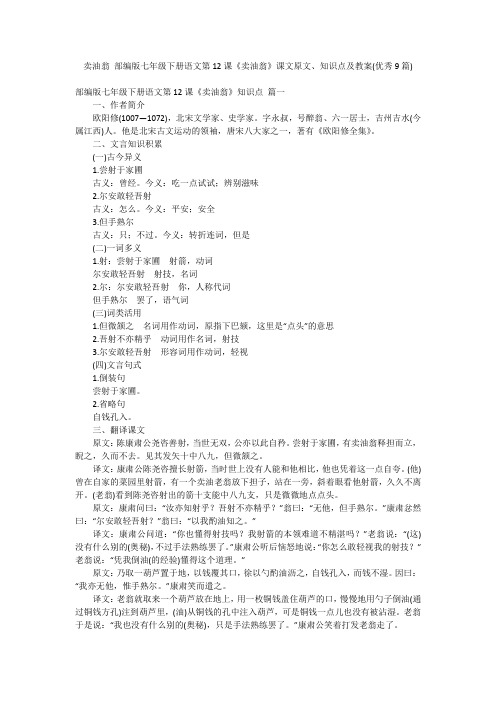
卖油翁部编版七年级下册语文第12课《卖油翁》课文原文、知识点及教案(优秀9篇)部编版七年级下册语文第12课《卖油翁》知识点篇一一、作者简介欧阳修(1007—1072),北宋文学家、史学家。
字永叔,号醉翁、六一居士,吉州吉水(今属江西)人。
他是北宋古文运动的领袖,唐宋八大家之一,著有《欧阳修全集》。
二、文言知识积累(一)古今异义1.尝射于家圃古义:曾经。
今义:吃一点试试;辨别滋味2.尔安敢轻吾射古义:怎么。
今义:平安;安全3.但手熟尔古义:只;不过。
今义:转折连词,但是(二)一词多义1.射:尝射于家圃射箭,动词尔安敢轻吾射射技,名词2.尔:尔安敢轻吾射你,人称代词但手熟尔罢了,语气词(三)词类活用1.但微颔之名词用作动词,原指下巴颏,这里是“点头”的意思2.吾射不亦精乎动词用作名词,射技3.尔安敢轻吾射形容词用作动词,轻视(四)文言句式1.倒装句尝射于家圃。
2.省略句自钱孔入。
三、翻译课文原文:陈康肃公尧咨善射,当世无双,公亦以此自矜。
尝射于家圃,有卖油翁释担而立,睨之,久而不去。
见其发矢十中八九,但微颔之。
译文:康肃公陈尧咨擅长射箭,当时世上没有人能和他相比,他也凭着这一点自夸。
(他)曾在自家的菜园里射箭,有一个卖油老翁放下担子,站在一旁,斜着眼看他射箭,久久不离开。
(老翁)看到陈尧咨射出的箭十支能中八九支,只是微微地点点头。
原文:康肃问曰:“汝亦知射乎?吾射不亦精乎?”翁曰:“无他,但手熟尔。
”康肃忿然曰:“尔安敢轻吾射?”翁曰:“以我酌油知之。
”译文:康肃公问道:“你也懂得射技吗?我射箭的本领难道不精湛吗?”老翁说:“(这)没有什么别的(奥秘),不过手法熟练罢了。
”康肃公听后恼怒地说:“你怎么敢轻视我的射技?”老翁说:“凭我倒油(的经验)懂得这个道理。
”原文:乃取一葫芦置于地,以钱覆其口,徐以勺酌油沥之,自钱孔入,而钱不湿。
因曰:“我亦无他,惟手熟尔。
”康肃笑而遣之。
译文:老翁就取来一个葫芦放在地上,用一枚铜钱盖住葫芦的口,慢慢地用勺子倒油(通过铜钱方孔)注到葫芦里,(油)从铜钱的孔中注入葫芦,可是铜钱一点儿也没有被沾湿。
《子衿》教案7

《子衿》教案7教案7:《子衿》一、教学内容本节课的教学内容选自《诗经》中的《子衿》。
教材章节为小学语文五年级上册第三单元第五课。
课文内容主要包括古代诗人通过描绘自然景物和人物形象,表达了对美好事物的向往和赞美。
二、教学目标1. 能够正确地朗读和背诵课文《子衿》。
2. 理解课文中的词语和句子,领会诗人的情感表达。
3. 培养学生对古代文学的兴趣,提高学生的文学素养。
三、教学难点与重点重点:正确朗读和背诵课文《子衿》。
难点:理解课文中的词语和句子,领会诗人的情感表达。
四、教具与学具准备1. 教具:课文课件、黑板、粉笔。
2. 学具:学生课本、练习本、文具。
五、教学过程1. 课前导入(5分钟)教师通过与学生交流,引导学生们谈论他们对美好事物的看法,激发学生们的学习兴趣。
然后,教师引入课文《子衿》,告诉学生们这将是一节关于古代诗人如何描绘美好事物的课程。
2. 课文朗读与翻译(10分钟)教师带领学生们朗读课文《子衿》,并逐句进行翻译,帮助学生们理解课文内容。
在翻译过程中,教师重点解释课文中的生僻词语和句子,让学生们能够正确理解诗人的意图。
3. 课文分析与讨论(10分钟)教师引导学生分析课文《子衿》的结构和表现手法,让学生们了解诗人如何通过描绘自然景物和人物形象来表达美好事物的向往和赞美。
同时,教师组织学生们进行小组讨论,让学生们分享彼此对课文的理解和感悟。
4. 实践情景引入(5分钟)教师创设一个实践情景,让学生们模拟诗人的角色,尝试自己创作一首描绘美好事物的诗歌。
学生们可以自由发挥,运用课文中的表现手法和词语,创作出自己的作品。
5. 例题讲解与随堂练习(10分钟)教师给出一个与课文相关的例题,讲解解题思路和技巧。
然后,教师布置随堂练习,让学生们运用所学的知识和技巧,独立完成练习题目。
6. 作业布置与答案解析(5分钟)教师布置作业,要求学生们朗读和背诵课文《子衿》。
同时,教师给出作业答案,并解析答案的来源和依据。
最新翻译理论基础7-风格与翻译
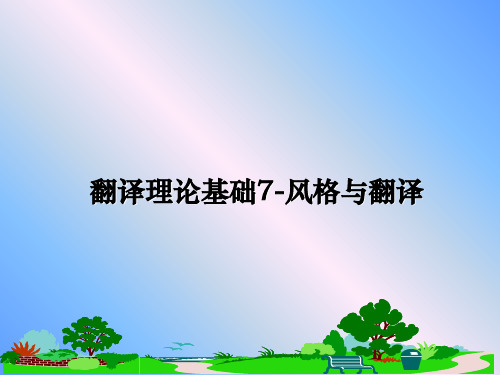
Translation practice
1) I beg, sir, that you will offer him my sincerest apologies.
敬请向他转达在下最诚挚的歉意。 2) Please send my sincerest apologies to
him. 请向他转达我最诚挚的歉意。 3) Tell him I’m awfully sorry. 告诉他我很抱歉。
formal gatherings, used in daily lives
用词准确与用词几乎准确,这两者之间的差异就如 同闪电与萤火虫之间的差异。
1989年版《辞海》是这样定义风格的: 作家、艺术家在创作中所表现出来的艺 术特色和创作个性,具有主观和客观两 个方面。主观方面是作家的创作追求, 客观方面是时代,民族,阶级乃至文体 对创作的规定性。
在北京外国语大学执教40余年的英籍专家 David Crook曾经讲过这样一件事 here.”
(没想到在这儿碰到你。)之后就到处套用。 而且有一次,一个学生在厕所里见到他还这么 说,令他十分尴尬。
Style is the man. (Buffon) (文如其人)
e.g. Li Bai VS Du Fu
李白
夜宿山寺 危楼高百尺, 手可摘星辰。 不敢高声语, 恐惊天上人。
杜甫
of a style. (Jonathan Swift)
(适当的词用于适当的场合,就是风格的确切定义。)
The difference between the right word and the almostright word is as great as that between lighting and the lighting bug. (Mark Twain)
Unit7ArtWritingWorkshop教学设计高一下学期英语北师大版

北师大版(2019)必修第三册Unit 7 ArtWriting Workshop教材分析:本节课的教材来源于北师大版(2019)的必修第三册Unit 7 Art Writing Workshop。
该单元主要以艺术写作为主题,通过学习并模仿一篇有关艺术品的英语写作,提高学生的写作能力。
教学目标:1. 了解艺术写作的特点和技巧,培养学生对艺术写作的兴趣。
2. 提高学生的写作能力,培养学生准确、流畅地表达自己的观点和情感。
3. 培养学生的创新意识和表达能力,使他们能够独立完成一篇关于艺术品的英语写作。
教学重点:1. 学习艺术写作的特点和技巧。
2. 学习如何用英语描述艺术品的外观、特点和观感。
3. 学习如何用恰当的词汇和语法表达自己对艺术品的评价和情感。
教学难点:1. 创造性地运用词汇和句型描述艺术品,并表达出个人的观点和情感。
2. 教导学生如何有条理地组织文章,使之通顺、连贯。
学情分析:学生是高一学生,具备一定的英语基础,但在写作方面可能存在一定的困难。
学生对艺术可能具备不同程度的理解和兴趣。
因此,需要通过本节课的教学,提高学生的写作能力,激发他们对艺术写作的兴趣,让他们能够准确、流畅地表达自己的观点和情感。
教学策略:1. 激发学生学习的兴趣,通过欣赏和讨论艺术作品,培养学生的艺术鉴赏能力和创新思维。
2. 引导学生进行合作学习,通过合作讨论和互相修改,提高学生的写作能力。
3. 利用多媒体技术,展示各种艺术品的图片和视频,帮助学生更好地理解和描述艺术品。
教学方法:1. 情境教学法:通过引入艺术品和实际情境,使学生更好地理解并运用所学的知识。
2. 合作学习法:通过小组讨论和互相修改,帮助学生共同进步,提高写作能力。
3. 示范教学法:老师可以用范文和示范来指导学生写作,让学生更好地理解写作技巧和要求。
4. 多媒体教学法:通过展示多种艺术作品的图片和视频,激发学生的兴趣,帮助他们理解和描述艺术品。
导入环节:导入内容:通过展示一幅经典的艺术作品,引起学生对艺术的兴趣和思考。
英译汉常用的方法和技巧(4-7)

第三章英译汉常用方法和技巧(教学安排:6课时)无论翻译的标准如何,翻译的目的都是要求译者最大程度地传递原文信息/再现原文风格,以求最大程度地“忠实”于原文。
翻译标准只是给译者提供了翻译的大方向,在具体的翻译运作过程中,还会遇到种种问题,所以在翻译实践中,还要灵活运用相应的翻译方法和技巧,从原文和译文的整体出发,全面分析,透过现象,抓住本质。
经过不断的翻译实践,翻译技巧一定会运用得越来越娴熟,翻译水平也会越来越高。
合理有效地运用翻译技巧可以使译文生辉,有效地提高翻译质量。
常用的翻译方法和技巧:直译和意译词义的选择省略法和增补法词类转译法重复法正反、反正表达法分译法和合译法直译和意译英汉两种语言的结构有相同的一面,也有不同的一面,因此翻译时有时使用直译,有时用意译,有时直译并举。
无论使用哪种方法,其原则是在忠实原文内容和风格的前提下,摆脱原文结构的束缚,使译文符合汉语的规范直译(metaphrase/literal translation)在不影响译入语的自然流畅并保持原文信息的前提下,在译文中既保持原文的内容信息,又保持原文的形式结构,尤其要保持原文的修辞、文体和文化特质。
to kill two birds with one stoneto shed crocodile tears如果不破坏原文结构,译文也能通顺自然且忠实原意,这是最理想的直译,但逐字对等且保持原文结构和语义的情况微乎其微。
直译法的使用不仅极大丰富了汉语的词汇,而且及大地拓展了汉语的表达方式和表达范围。
汉语中的外来语大都采用直译法或音译法。
例如:lady-killer talk show mad cow diseasebird flu chain reaction cat walkhumor second-hand car tittuphippy yuppie shock例1原文:There are two types of electric current: alternating current in which the current flows first one way then the other in a forward and backward motion, and direct current which flows the same way all the time.译文:例2原文:Losing one’s independence for Americans is a shameful thing.例3原文:Italian gourmets are protesting against the invasion of foreign foods on the dinner table.译文:例4原文:In short, when employees leave their performance reviews, they should be focusing on what they can do better in the year ahead, not worrying about what went into their files about the past.译文:例5原文:But when I look at the Third World and think “What can I do to solve this?”, my reaction isn’t to say “Let’s bring population down immediately”.译文:例6原句:Hitler was armed to the teeth when he launched the Second World War, but in a few years, he was completely defeated.译文:例7原文:People are always talking about “the problem of yo uth.” I f there is one, then it is older people who create it, not the young people themselves. Let us get down to fundamentals and agree that the young are after all human beings—people just like their elders. There is only one difference between an old man and a young one: the young man has a glorious future before him and the old one has a splendid future behind him, and maybe that is where the rub is.译文:直译不等于死译、硬译,直译也需要灵活变通,不能只求形式对等而破坏原文内容。
给你不一样的英语课:八年级上Unit7教案

给你不一样的英语课:八年级上Unit7教案。
八年级上Unit 7教案的重点在于让学生变成主动学习者。
这意味着在教师的带领下,学生可以自行探索英语的知识和规则,让学生不再只是被动吸收知识而是学会主动思考。
例如,在介绍动名词时,教师并不会仅仅给出正确的答案,而是让学生根据给出的句子自己去发现动名词,并了解其使用方法。
这种让学生自己找寻答案的方法能够让学生更加深入理解英语规则,能够加强学生在英语学习中的主动性、积极性和自信心。
这个教案还添加了互动环节。
教师在教学过程中设计了多个合作小组的环节,让学生在小组中讨论并尝试解决问题。
这不仅可以培养每个学生的合作精神,而且还增加了学生对于英语学习的兴趣。
在小组中讨论是不同于单独学习的,学生们能够交流彼此的策略,分享学习经验,相互促进,从而取得更好的成果。
值得一提的是,教师还采用了许多多媒体辅助教学过程,例如使用视频、图片等工具来更好地丰富教学内容,让学生实现多媒体手段在英语学习上的应用,提高学生的视听能力,让学生在不断适应不同环境中掌握英语知识。
八年级上Unit 7教案给予了学生与传统英语课不同的学习体验。
教师从不同角度仔细规划和设计课程,充分利用小组合作、互动沟通等形式,调动了学生的学习热情和积极性,增强学生主动性、创造性和思维能力。
在未来的日子里,教师们应该更加关注学生的需求,为
学生们提供更加智能化、有趣和贴近生活的教学资源,让走进课堂的每一位学生都能够享受到这样的学习体验。
《卖油翁》教案七篇
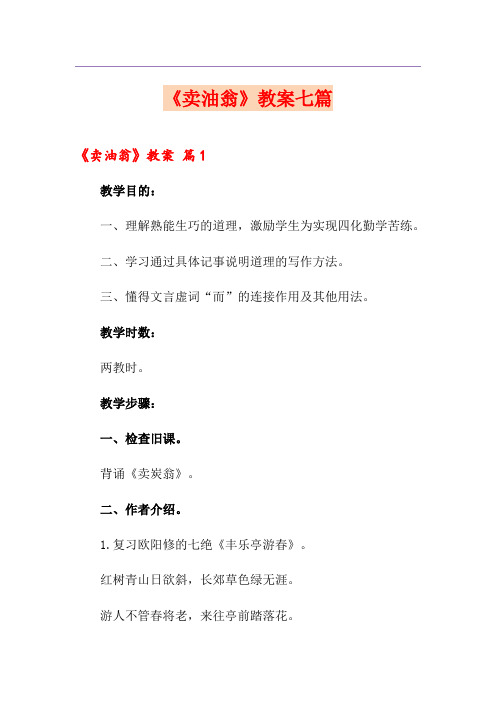
《卖油翁》教案七篇《卖油翁》教案篇1教学目的:一、理解熟能生巧的道理,激励学生为实现四化勤学苦练。
二、学习通过具体记事说明道理的写作方法。
三、懂得文言虚词“而”的连接作用及其他用法。
教学时数:两教时。
教学步骤:一、检查旧课。
背诵《卖炭翁》。
二、作者介绍。
1.复习欧阳修的七绝《丰乐亭游春》。
红树青山日欲斜,长郊草色绿无涯。
游人不管春将老,来往亭前踏落花。
2.欧阳修(10CR--1072),字永叔,自号醉翁,又号六一居士,北宋吉州永丰人。
他是当时公认的文坛领袖,是一个在散文、诗、词各方面都成就卓著的作家。
他团结和培养了许多著名作者,领导了北宋古文运动。
以往所说“唐宋八大家”,就有六大家属于这个时期的这批作家里的。
八大家是:唐的韩愈、柳宗元、宋的欧阳修、王安石、曾巩、苏洵、苏拭和苏辙。
韩、苏、王的绝句我们曾学过一些。
欧阳修是北宋古文运动的领袖,一生写了大量散文作品。
他的__简洁明畅,说理透辟,状物抒情挥洒自如,语言精练而不奇顺,文辞婉转曲折,具有潇洒的风格和浓厚的抒情气息。
下学期我们要学习他的名篇《醉翁亭记》,更可领略其妙处。
__仅135字,可算散文中的小品,选自《归田录》。
该书是一部记载朝廷轶事和士大夫诙谐之言的书。
请同学试答:__主要记叙了怎样的一件事?写了哪几个人?这个故事告诉我们怎样一个道理?三、领读全文,注意句读,注意句中停顿。
四、讲读第1节。
第1节写一射一看。
思考:1.故事中先出现的陈尧咨这个人物有何特点?(射者)2.卖油翁是在怎样场景中出现的?动作、神态如何?(静中有动)3.要求学生对照注释逐字逐句讲解。
指点:(1)把句中省略的主语补上。
(2)“以”、“于”、“而”、“但”、“之”、“中”等词的词性词义辨清楚。
(3)比较:举世无双,当世无双,首屈一指;正视,注视;微领,赞许,喝采。
(4)射者与观者评价不一,有矛盾。
4.学生读熟第1节,注意人物的语气。
五、讲读第2节。
写射者与看者引人深思的对话。
Unit7ArtTopicTalk教学设计-高一下学期英语北师大版

北师大版(2019)必修第三册Unit 7 ArtTopic Talk教材分析:该节课教材为北师大版(2019)必修第三册Unit 7 Art Topic Talk。
该课程主要涉及艺术领域的话题,包括艺术家的生活经历、艺术作品的描述和评论等内容。
教材内容比较丰富,涵盖了绘画、音乐、雕塑等不同艺术形式。
教学目标:1. 知识与技能目标:学习艺术家的生活经历、艺术作品的描述和评论等相关知识,提高学生对不同艺术形式的理解能力。
2. 过程与方法目标:培养学生的合作意识和表达能力,通过小组讨论、展示等活动形式,提高学生的语言沟通能力和团队合作能力。
3. 情感态度目标:激发学生对艺术的兴趣,培养学生的艺术鉴赏能力和审美情操。
教学重点:1. 学习艺术家的生活经历和艺术作品的描述及评论。
2. 提高学生的团队合作和表达能力。
教学难点:1. 学生对不同艺术形式的理解以及对艺术作品的感受和评论。
2. 学生在小组讨论和展示过程中的协作和表达能力。
学情分析:学生为高一学生,具有一定的英语基础,能够进行简单的阅读和口语表达。
但由于艺术领域的专业术语较多,学生可能对艺术作品的理解和表达存在困难。
同时,学生处于青春期,兴趣多样化,部分学生可能对艺术领域缺乏兴趣或理解。
教学策略:1. 引导学生通过实际观察、描述和评论的方式,激发学生对艺术的兴趣。
2. 通过小组活动、展示等形式,培养学生的团队合作意识和表达能力。
3. 激发学生的创造力和想象力,鼓励他们提出不同的观点和见解。
教学方法:1. 案例分析法:通过介绍艺术家的生活经历和艺术作品的描述,引导学生进行讨论和分析。
2. 合作学习法:组织学生进行小组讨论和展示,鼓励他们相互合作、交流和互动。
3. 情景教学法:设计多种情境,让学生在情景中进行艺术作品的描述和评论,增加学习的趣味性。
通过以上设计,我将能够结合自己的教学经验,开展一堂富有启发性和互动性的高一英语艺术课。
导入环节:导入环节的目的是激发学生对艺术主题的兴趣,增加他们对艺术的理解和认识。
高中英语新北师大版必修第三册 Unit 7 Art—Viewing workshop 教案
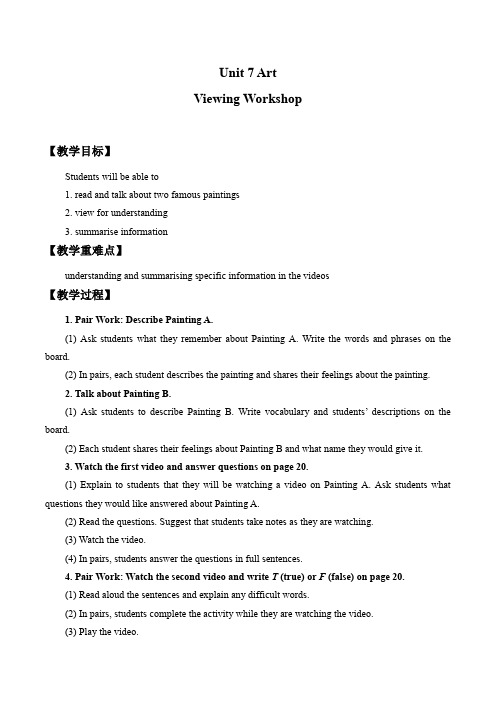
Unit 7 ArtViewing Workshop【教学目标】Students will be able to1. read and talk about two famous paintings2. view for understanding3. summarise information【教学重难点】understanding and summarising specific information in the videos【教学过程】1. Pair Work: Describe Painting A.(1) Ask students what they remember about Painting A. Write the words and phrases on the board.(2) In pairs, each student describes the painting and shares their feelings about the painting.2. Talk about Painting B.(1) Ask students to describe Painting B. Write vocabulary and students’ descriptions on the board.(2) Each student shares their feelings about Painting B and what name they would give it.3. Watch the first video and answer questions on page 20.(1) Explain to students that they will be watching a video on Painting A. Ask students what questions they would like answered about Painting A.(2) Read the questions. Suggest that students take notes as they are watching.(3) Watch the video.(4) In pairs, students answer the questions in full sentences.4. Pair Work: Watch the second video and write T (true) or F (false) on page 20.(1) Read aloud the sentences and explain any difficult words.(2) In pairs, students complete the activity while they are watching the video.(3) Play the video.(4) Discuss the answers as a class.5. Watch again and answer questions on page 20.(1) In pairs, student read through the questions and answer them as they watch both videos.(2) Watch both videos.(3) Review the answers as a class.6. Group Work: Introduce your favourite painting.(1) Each student chooses one painting and writes a few sentences on why it is their favourite. Answer:a. How does the painting make you feel?b. What do you like about the painting?c. What caught your eye about the painting first?d. Describe the features of the painting.(2) In small groups, students introduce their favourite painting.。
海明威的写作风格与汉语翻译技巧赏析
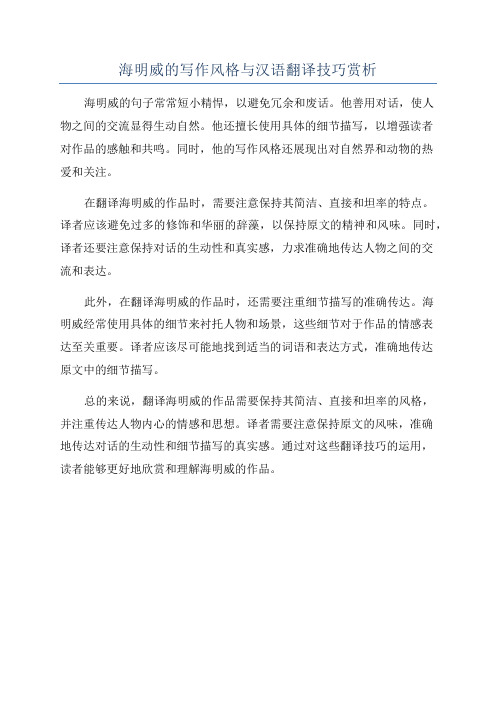
海明威的写作风格与汉语翻译技巧赏析海明威的句子常常短小精悍,以避免冗余和废话。
他善用对话,使人
物之间的交流显得生动自然。
他还擅长使用具体的细节描写,以增强读者
对作品的感触和共鸣。
同时,他的写作风格还展现出对自然界和动物的热
爱和关注。
在翻译海明威的作品时,需要注意保持其简洁、直接和坦率的特点。
译者应该避免过多的修饰和华丽的辞藻,以保持原文的精神和风味。
同时,译者还要注意保持对话的生动性和真实感,力求准确地传达人物之间的交
流和表达。
此外,在翻译海明威的作品时,还需要注重细节描写的准确传达。
海
明威经常使用具体的细节来衬托人物和场景,这些细节对于作品的情感表
达至关重要。
译者应该尽可能地找到适当的词语和表达方式,准确地传达
原文中的细节描写。
总的来说,翻译海明威的作品需要保持其简洁、直接和坦率的风格,
并注重传达人物内心的情感和思想。
译者需要注意保持原文的风味,准确
地传达对话的生动性和细节描写的真实感。
通过对这些翻译技巧的运用,
读者能够更好地欣赏和理解海明威的作品。
七年级英语上册 Unit 8 Fashion教案 (新版)牛津版-(新版)牛津版初中七年级上册英语教
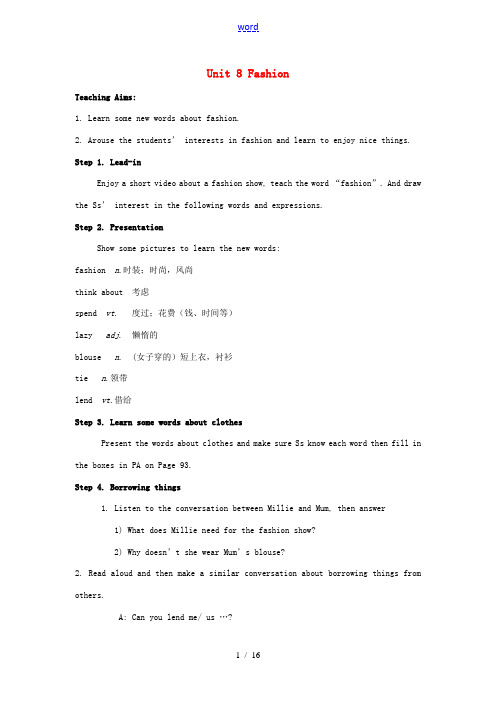
Unit 8 FashionTeaching Aims:1. Learn some new words about fashion.2. Arouse the students’ interests in fashion and learn to enjoy nice things. Step 1. Lead-inEnjoy a short video about a fashion show, teach the word “fashion”. And d raw the Ss’ int erest in the following words and expressions.Step 2. PresentationShow some pictures to learn the new words:fashion n.时装;时尚,风尚think about 考虑spend vt. 度过;花费(钱、时间等)lazy adj. 懒惰的blouse n. (女子穿的)短上衣,衬衫tie n.领带lend vt.借给Step 3. Learn some words about clothesPresent the words about clothes and make sure Ss know each word then fill in the boxes in PA on Page 93.Step 4. Borrowing things1. Listen to the conversation between Millie and Mum, then answer1) What does Millie need for the fashion show?2) Why doesn’t she wear Mum’s blouse?2. Read aloud and then make a similar conversation about borrowing things from others.A: Can you lend me/ us …?B: Of course.A: What size/ colour is/ are your …?B: …A: Oh, it’s … but … can … it/ them.B. OK then.A: Thank you, …Step 5. Listen and fill in the blanks.Listen to the conversation between Eddie and Hobo on Page 92, then fill the blanks:Eddie is ________ about what to wear. But Hobo tells him dogs d on’t _______ clothes. So Eddie wants to ________ ten more minutes in bed. He is a ______ dog. Step 6. Read and actRead aloud the conversation in groups, then present the ic strip on the screen for the Ss to act out the conversation.Step 7. Explain1. wear 穿着,戴着(表示穿、戴的状态)put on 穿上,戴上(表示穿戴的动作)e.g. She likes wearing red.她喜欢穿红色。
第七章 英语长句的译法(14)
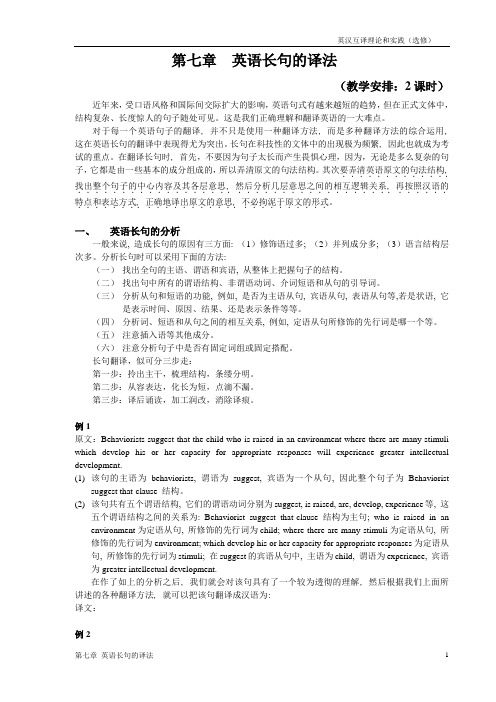
第七章英语长句的译法(教学安排:2课时)近年来,受口语风格和国际间交际扩大的影响,英语句式有越来越短的趋势,但在正式文体中,结构复杂、长度惊人的句子随处可见。
这是我们正确理解和翻译英语的一大难点。
对于每一个英语句子的翻译, 并不只是使用一种翻译方法, 而是多种翻译方法的综合运用, 这在英语长句的翻译中表现得尤为突出。
长句在科技性的文体中的出现极为频繁, 因此也就成为考试的重点。
在翻译长句时, 首先,不要因为句子太长而产生畏惧心理,因为,无论是多么复杂的句子,它都是由一些基本的成分组成的,所以弄清原文的句法结构。
其次要弄清英语原文的句法结构............, .找出整个句子的中心内容及其各层意思......................., .再按照汉语的................., .然后分析几层意思之间的相互逻辑关系特点和表达方式..........。
.........., .不必拘泥于原文的形式......., .正确地译出原文的意思一、英语长句的分析一般来说, 造成长句的原因有三方面: (1)修饰语过多; (2)并列成分多; (3)语言结构层次多。
分析长句时可以采用下面的方法(一)找出全句的主语、谓语和宾语, 从整体上把握句子的结构。
(二)找出句中所有的谓语结构、非谓语动词、介词短语和从句的引导词。
(三)分析从句和短语的功能, 例如, 是否为主语从句, 宾语从句, 表语从句等,若是状语, 它是表示时间、原因、结果、还是表示条件等等。
(四)分析词、短语和从句之间的相互关系, 例如, 定语从句所修饰的先行词是哪一个等。
(五)注意插入语等其他成分。
(六)注意分析句子中是否有固定词组或固定搭配。
长句翻译,似可分三步走:第一步:拎出主干,梳理结构,条缕分明。
第二步:从容表达,化长为短,点滴不漏。
第三步:译后诵读,加工润改,消除译痕。
例1原文:Behaviorists suggest that the child who is raised in an environment where there are many stimuli which develop his or her capacity for appropriate responses will experience greater intellectual development.(1)该句的主语为behaviorists, 谓语为suggest, 宾语为一个从句, 因此整个句子为Behavioristsuggest that-clause 结构。
Unit7ArtLesson1Masterpieces教学设计高一英语北师大版

Unit 7 ArtLesson 1 Period 1教材分析本课是阅读篇目,介绍了三幅世界名画,其主题意义在于通过让学生通过阅读对世界名画的介绍,对绘画这一艺术形式有更深刻的了解,并学会描述和欣赏这种艺术形式。
教学目标在本课学习结束时,学生能够:1. 阅读文章大意。
2. 阅读具体信息并理解上下文中的词意。
3. 用英文谈论绘画艺术。
教学重难点【教学重点】1. 阅读文章大意。
2. 阅读具体信息并理解上下文中的词意。
【教学难点】用英文鉴赏和谈论艺术。
教学过程Step 1 Warmingup1. What do you think is the highest honor for an artist?2. Recognize and describe some masterpieces of painting.设计意图:创设情境,引入主题,铺垫语言。
Step 2 ReadingRead the text and fill in the form about the paintings.Try to focus on the description, inspiration and ments of the paintings.设计意图:基于主题引导学生获取初步信息,导出核心问题。
Step 3 TalkingSuppose you are in a class of art appreciation.Introduce one of the paintings to your classmates.Use the following information to help you and add your own opinion.设计意图:理解、领会介绍艺术作品的要点,并内化、运用语言进行表达。
Step 4 Discussion1. What do you think are the features of a good painting?2. How do you understand the following quotes?• A man paints with his brain and not his hands.•Painting is silent poetry and poetry is painting that speaks.•Good painting is like good cooking; it can be tasted, but not explained.设计意图:巩固所学知识,培养语言能力和思维品质。
七、翻译技巧(3)增词法与重复法
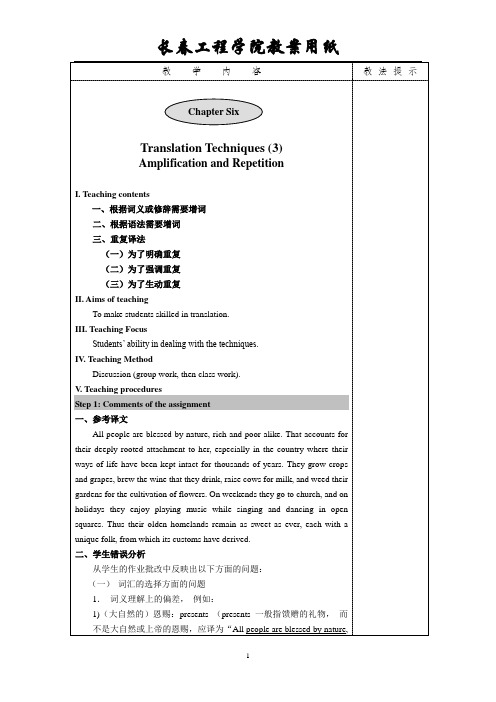
2
长春工程学院教案用纸
1. 逐字翻译, 画蛇添足。例如: [例 1] 在周末去教堂祈祷和做礼拜, 在节日到广场拉琴、跳 舞和唱歌; 误译:On weekends they go to church to pray and do religious services, in holidays, they go to the square to play musical instruments, dance and sing; 改译:On weekends they go to church, and on holidays they enjoy playing music while singing and dancing in open squares. [例 2] 往日的田园依旧是今日温馨家园。 误译:Those fields in the past/of yesterday are still cozy homelands at present/nowadays/of today. 改译:Thus their olden homelands remain as sweet as ever…( “现 在” 用现在时态体现即可。曾经、往日等用过去时态表示。 ) [例 3] 上学读书:go to school to study (go to school) 2. 重复不当, 不符合英语表达习惯。 [例] 所以人们对于大自然大全都一致并深深地依赖着。 尤其是在 乡间, 上千年来人们一直以不变的方式生活着。 原译:So people all deeply depend on nature. Especially in the countryside, people keep the unchangeable way of lives for thousands of years. 改译: That accounts for their deep-rooted attachment to her, especially in the country where their ways of life have been kept intact for thousands of years. 分析: 分析 此处学生把 people 重复了两遍, 很不自然。因为汉语里的 名词可以不厌其烦地重复,而英语中,一个刚刚提到的名词在相邻 的句子中通常是不能重复的。 3. 断句不当,割裂语篇。 [例] 大自然对人的恩赐, 无论贫富, 一律平等。 原译 1:Nature always distributes its resources to human beings. And every man gets equally from it. 原译 2:The gifts bestowed by nature are equally distributed among mankind. No matter one is rich or poor, he receives the same from the nature. 改译:All people are blessed by nature, rich or poor alike. 改进措施: 改进措施 增大练习力度, 尤其是汉译英的练习力度, 使学生能够更 好地驾驭两种语言,做好翻译工作。 Step 2 Amplification in translation (增词译法). 翻译时为了尽可能使译文的意义、语气、语态等切合原文,常常要
四语七册第七单元翻译教案

目前四语七册正逐渐成为学生学习翻译的首选教材,其以系统全面和实用性强等特点备受广大学生的青睐。
而其第七单元的翻译教案更是备受推崇,我们就一起来看看四语七册第七单元翻译教案的具体内容和优缺点。
一、教案的内容四语七册第七单元的翻译教案主要分为三大部分,分别是理论部分、实践部分和复习部分。
理论部分主要介绍了翻译的定义、分类、步骤和方法等相关知识。
其中还有翻译的标准和常见问题的分析,让学生对翻译有了更深刻的理解和认识。
实践部分主要是以各类实际翻译文本为例,搭配做翻译训练。
如新闻报道、商业合同、广告宣传等不同类型的文本,让学生通过实践翻译中逐步熟悉各类文本特点,掌握翻译方法和技巧。
复习部分主要是回顾了整个单元所学内容,让学生更加熟悉掌握每个知识点,为下一步进一步的学习打下基础。
二、教案的优点1、理论和实践相结合:理论部分全面深入且实用,实践部分真实可靠而且具有很强的现实意义,二者结合让学生能够从理论到实践的全面掌握翻译技巧和方法。
2、涉及多种类型文本:实践部分覆盖了多种类型的文本,让学生更易于了解翻译的用法和方法,能够适应不同类型文本的翻译需求。
3、掌握翻译方法和技巧:教案的重点不是流水账的翻译内容,而是让学生了解翻译的方法和技巧,通过示范案例让学生能够自主学习和掌握翻译的方法。
4、思维导图式学习:教案采用思维导图式的学习理念,全面深刻的让学生了解翻译的流程和方法,便于实际应用。
三、教案的缺点1、语言复杂度较高:教材的语言难度较大,对于英语基础较差的学生来说,难以轻松理解和掌握。
建议教师进行适当的调整,用浅显的语言解释课程内容。
2、实践部分不尽人意:虽然教师在设计实践部分时很努力,将不同类型文本都统计进去,但是针对某些类型的文本,实践情节过于繁琐,需要一定程度的技巧,仍需要教师进行适当指导。
四、总结通过以上分析,我们不难看出四语七册第七单元翻译教案是一本非常好的课程教材,但也需要教师根据自己教学经验适当的进行调整,让学生更易于理解和掌握翻译的方法。
2017届语文一轮教学案专题8第7讲理解和翻译文中的句子(含解析)
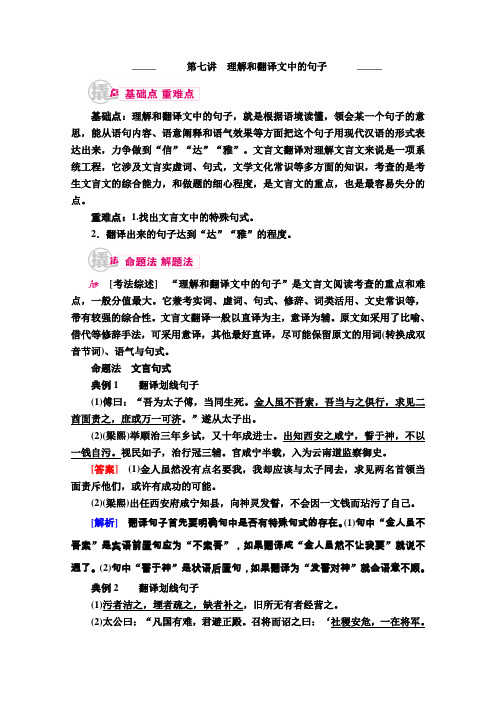
第七讲理解和翻译文中的句子基础点:理解和翻译文中的句子,就是根据语境读懂,领会某一个句子的意思,能从语句内容、语意阐释和语气效果等方面把这个句子用现代汉语的形式表达出来,力争做到“信”“达”“雅”。
文言文翻译对理解文言文来说是一项系统工程,它涉及文言实虚词、句式,文学文化常识等多方面的知识,考查的是考生文言文的综合能力,和做题的细心程度,是文言文的重点,也是最容易失分的点。
重难点:1.找出文言文中的特殊句式。
2.翻译出来的句子达到“达”“雅”的程度。
[考法综述]“理解和翻译文中的句子”是文言文阅读考查的重点和难点,一般分值最大。
它兼考实词、虚词、句式、修辞、词类活用、文史常识等,带有较强的综合性。
文言文翻译一般以直译为主,意译为辅。
原文如采用了比喻、借代等修辞手法,可采用意译,其他最好直译,尽可能保留原文的用词(转换成双音节词)、语气与句式。
命题法文言句式典例1翻译划线句子(1)傅曰:“吾为太子傅,当同生死。
金人虽不吾索,吾当与之俱行,求见二酋面责之,庶或万一可济。
”遂从太子出。
(2)(梁熙)举顺治三年乡试,又十年成进士。
出知西安之咸宁,誓于神,不以一钱自污。
视民如子,治行冠三辅。
官咸宁半载,入为云南道监察御史。
[答案](1)金人虽然没有点名要我,我却应该与太子同去,求见两名首领当面责斥他们,或许有成功的可能。
(2)(梁熙)出任西安府咸宁知县,向神灵发誓,不会因一文钱而玷污了自己。
[解析]翻译句子首先要明确句中是否有特殊句式的存在。
(1)句中“金人虽不吾索”是宾语前置句应为“不索吾”,如果翻译成“金人虽然不让我要”就说不通了。
(2)句中“誓于神”是状语后置句,如果翻译为“发誓对神”就会语意不顺。
典例2翻译划线句子(1)污者洁之,堙者疏之,缺者补之,旧所无有者经营之。
(2)太公曰:“凡国有难,君避正殿。
召将而诏之曰:‘社稷安危,一在将军。
今某国不臣,愿将军帅师应之也’。
”[答案](1)肮脏的清扫它,堵塞的疏通它,缺失的补上它。
Unit7ArtViewingWorkshop教学设计高一下学期英语北师大版

北师大版(2019)必修第三册Unit 7 ArtViewing Workshop教材分析:《北师大版(2019)必修第三册Unit 7 Art Viewing Workshop》是一节关于艺术欣赏的课程。
该课程主要围绕艺术品的欣赏和鉴赏展开,让学生了解不同的艺术形式,并通过观看图片和短片等活动来培养学生的艺术鉴赏能力。
教学目标:1.了解不同的艺术形式和风格,包括绘画、摄影、雕塑等。
2.学会运用英语谈论和描述艺术作品,并对其进行评价。
3.培养学生的艺术欣赏能力和审美情趣,提升学生的创造力和表达能力。
教学重点:1.学习和掌握艺术品的基本词汇和表达方式。
2.培养学生观察、分析和评价艺术作品的能力。
教学难点:1.培养学生鉴赏艺术作品的能力,包括识别、分析和评价。
2.提升学生的英语口语表达能力,让他们能够用英语流利地谈论和描述艺术作品。
学情分析:学生是高一年级的学生,他们对艺术品的了解和欣赏经验可能相对有限。
他们大多数是初次接触艺术欣赏课程,需要从艺术品的基本知识和鉴赏方法入手。
学生可能已经学过一定的英语基础,但对于艺术词汇和描述方式需要学习和扩充。
教学策略:1.以图片和短片等多媒体方式展示艺术作品,吸引学生的兴趣和注意力。
2.通过小组合作学习,激发学生的参与和思考,培养他们的合作和交流能力。
3.使用多样的艺术作品和形式,以满足不同学生的兴趣和需求。
教学方法:1.教师讲解与引导:教师通过讲解和引导,介绍艺术作品的背景、风格和表达方式,帮助学生理解和欣赏艺术作品。
2.小组合作学习:学生在小组内观看和讨论艺术作品,分享自己的观点和见解,培养他们的合作和交流能力。
3.个人创造与表达:学生通过个人写作或口语表达等方式,展示自己对艺术作品的理解和感受,提升他们的创造力和表达能力。
导入环节(约5分钟):教学内容:引导学生了解艺术欣赏活动的重要性。
教学活动:首先,我会向学生们提出问题,比如:“你们对艺术欣赏有什么了解?你们之前有参观过美术馆或者画展吗?你们觉得艺术欣赏对人有什么好处?”通过讨论的方式,让学生们分享自己的看法和经验。
教案7:风格与翻译
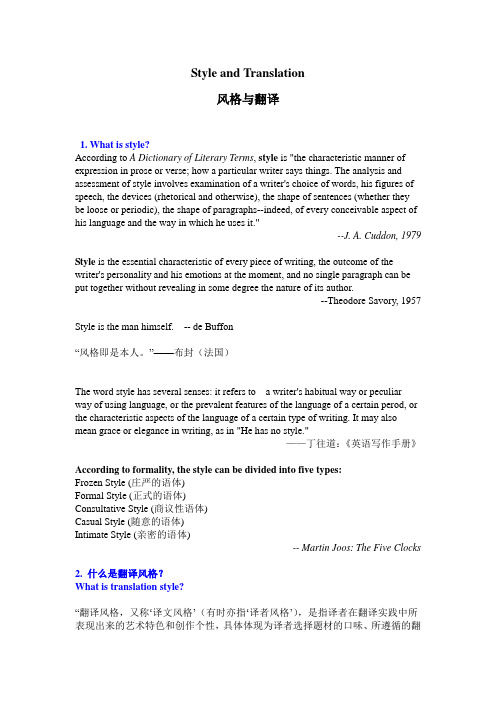
Style and Translation风格与翻译1. What is style?According to A Dictionary of Literary Terms, style is "the characteristic manner of expression in prose or verse; how a particular writer says things. The analysis and assessment of style involves examination of a writer's choice of words, his figures of speech, the devices (rhetorical and otherwise), the shape of sentences (whether they be loose or periodic), the shape of paragraphs--indeed, of every conceivable aspect of his language and the way in which he uses it."--J. A. Cuddon, 1979 Style is the essential characteristic of every piece of writing, the outcome of the writer's personality and his emotions at the moment, and no single paragraph can be put together without revealing in some degree the nature of its author.--Theodore Savory, 1957 Style is the man himself. -- de Buffon“风格即是本人。
翻译理论基础7 风格与翻译
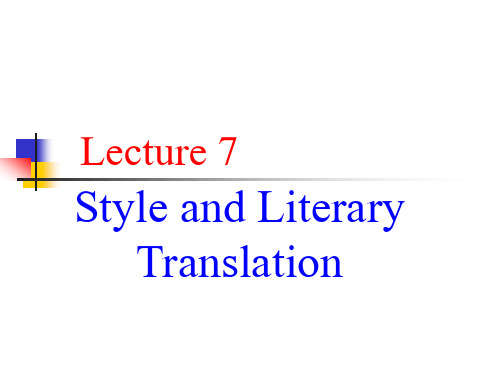
Translation practice
1) I beg, sir, that you will offer him my sincerest apologies. 敬请向他转达在下最诚挚的歉意。 2) Please send my sincerest apologies to him. 请向他转达我最诚挚的歉意。 3) Tell him I’m awfully sorry. 告诉他我很抱歉。
e.g. A) Visitors would make their way at (frozen) once to the upper floor by way of the staircase. (formal) B) Visitors should go up the stairs at once. C) Would you mind going upstairs (consultative) please? D) Time you all went upstairs now. (casual) E) Up you go, Chaps! (intimate)
3. Style and Literary Translation
the language of literature is used as an artistic medium, to create images, to bring out the rich multi-level meaning and thematic significance of a literary work.
Lecture 7
Style and Literary Translation
- 1、下载文档前请自行甄别文档内容的完整性,平台不提供额外的编辑、内容补充、找答案等附加服务。
- 2、"仅部分预览"的文档,不可在线预览部分如存在完整性等问题,可反馈申请退款(可完整预览的文档不适用该条件!)。
- 3、如文档侵犯您的权益,请联系客服反馈,我们会尽快为您处理(人工客服工作时间:9:00-18:30)。
Style and Translation
风格与翻译
1. What is style?
According to A Dictionary of Literary Terms, style is "the characteristic manner of expression in prose or verse; how a particular writer says things. The analysis and assessment of style involves examination of a writer's choice of words, his figures of speech, the devices (rhetorical and otherwise), the shape of sentences (whether they be loose or periodic), the shape of paragraphs--indeed, of every conceivable aspect of his language and the way in which he uses it."
--J. A. Cuddon, 1979 Style is the essential characteristic of every piece of writing, the outcome of the writer's personality and his emotions at the moment, and no single paragraph can be put together without revealing in some degree the nature of its author.
--Theodore Savory, 1957 Style is the man himself. -- de Buffon
“风格即是本人。
”——布封(法国)
The word style has several senses: it refers to a writer's habitual way or peculiar way of using language, or the prevalent features of the language of a certain perod, or the characteristic aspects of the language of a certain type of writing. It may also mean grace or elegance in writing, as in "He has no style."
——丁往道:《英语写作手册》According to formality, the style can be divided into five types:
Frozen Style (庄严的语体)
Formal Style (正式的语体)
Consultative Style (商议性语体)
Casual Style (随意的语体)
Intimate Style (亲密的语体)
-- Martin Joos: The Five Clocks 2. 什么是翻译风格?
What is translation style?
“翻译风格,又称…译文风格‟(有时亦指…译者风格‟),是指译者在翻译实践中所表现出来的艺术特色和创作个性,具体体现为译者选择题材的口味、所遵循的翻
译标准、采用的翻译方法以及译文语言的表现手法等特点。
”
3. 影响翻译风格形成的因素:
首先,翻译风格受译者自身风格的影响。
译者个人的性格气质、学识休养、工作态度、表现手法、语言特色以及翻译的目的等因素都会对翻译的风格产生影响。
其次,翻译风格受翻译客体——源语文本的影响。
第三,翻译风格受译者所处的特定时代或特定社会文化环境的影响。
4. Can style be translated?
思考题:1)风格绝对不可译吗?2)风格百分之百可译吗?3)如何看待风格不可译问题?
比较中肯的说法是,风格在一定程度上是可译的,但要做到完全地、百分之一百的复制原作的风格是不可能完成的任务。
4.1 风格是可以传译的。
1)正确理解原文,忠实传达风格
例:“If you say so,” Mace said skeptically. “But from where I‟m sitting, you sound more like a salesman than a scientist.”
译文1:“你可以这么说,”梅斯不信任地说道:“可在我听来,你与其说像个科学家,不如说像个推销员。
”
译文2:“这是你说的,” 梅斯的口气充满了怀疑。
“不过在我听来,你倒是像个生意人,不像个搞科学的。
”
2)力争形神皆似,追求风格对等
例:
A thousand moustaches can live together, but not four breasts.
译文1:一千个男人可以住在一起,两个女人却不行。
译文2:千条汉子能共处,两个婆娘难相容。
例1:
Pays as he speaks, my dear child—through the nose. (成语pay through the nose是肯出大价钱的意思)
译文1:报酬正如他说话,我亲爱的孩子—是从鼻子里。
译文2:他花钱也跟他说话一样,他是说大话,也是使大钱的。
例2:I would add, that to me she seems to throw herself away.
译文1:我要加上一句,我觉得她似乎是自暴自弃。
译文2:那我就得再添上一句说,我看,她这是把自己这朵鲜花插在牛粪上。
4.2 风格是不可传译的。
例如:
海水朝朝朝朝朝朝朝落,
浮云长长长长长长长消。
(对联)
Sea waters tide, day to day tide, everyday tide and everyday ebb.
Floating clouds appear, often appear, often appear and often go.
-- by Eugene Nida
4.3 必须用发展的眼光看待风格不可译问题。
风格不可译问题不是绝对的,有些风格翻译的难题会随着时间的推移而得到解决。
例如:
人曾是僧,人弗能成佛;
女卑为婢,女又可称奴。
A Buddhist cannot bud into a Buddha;
A maiden maybe made a house maid.
—许渊冲译
5. 风格翻译的标准
关于文体的翻译,王佐良认为:
不同的文体要有不同的译法。
例如,信息类译意,文艺类译文,通知、广告类译体,等等。
关于诗歌翻译的风格问题,王佐良认为,一切照原作,雅俗如之,深浅如之,口气如之,文体如之。
所谓意,是指内容、事实、数据等等,需力求准确,表达法要符合当代国际习惯。
所谓文,是指作家个人的感情色彩、文学手法、结构形式等等,需力求保持原貌,因此常需直译。
所谓体,是指格式、方式、措词等等,需力求符合该体在该语中的惯例,决不能“以我为主”,把商品广告译成火气甚重的政治宣传品等等。
但这并不意味着亦步亦趋,否则只会适得其反。
例如:
1) “Site” refers to the land and other places on, under, in or through which the Permanent Works or Temporary Works designed by the engineer are to be executed.
译文一:
“现场”指工程师设计的永久性或临时性工程所需的土地及其他场地。
译文二:
“现场”指工程师设计的永久工程或临时性工程所需的土地及其他场所,包括地面、地下、工程范围之内或途径的部分。
关于告示、广告的翻译,请看以下例子:
1. “油漆未干” (告示)
译文:Wet Paint
2. 穿上双星鞋,潇洒走世界。
(广告)
译文:Double Star Takes You Afar.
3. Good to the last drop! (广告)
译文:滴滴香浓,意犹未尽! (雀巢咖啡)。
